The game is designed to be played by 3 to 6 players and uses one standard 52 card deck in which two Jokers have been added. These two Jokers should each be distinguishable from one another, as one Joker is set as the Big Joker and the other the Small Joker. As most standard packs come with one colored Joker and another black and white Joker, the colored Joker is usually designated as the Big Joker and the black and white Joker as the Small Joker. The ranking of the cards in this deck are as follows (from high to low): Big Joker, Small Joker, 2, Ace, King, Queen, Jack, 10, 9, 8, 7, 6, 5, 4, 3. The suits do not have a relative ranking in Zheng Fen as they often do in many other games of this type.
Determination of seating positions and the player to have the first draw can be performed using a variety of methods, with drawing for high cards a common method. Each player would thus draw a card from the shuffled deck and would take a choice of seats at the table in the order of cards drawn from highest to lowest. If two or more players draw cards of the same denomination, these players would discard that card and draw another card from the deck until drawing a card which no other player has yet drawn. The player who drew the highest card of all would be set as the first drawer. Thus, this player would thoroughly shuffle the cards and offer it to the player at his left to cut. In Zheng Fen, as in most other Chinese card games, the cards are actually drawn by each player rather than dealt out by a specific dealer. Thus, after the deck is cut, it is placed in the center of the table. The player who was designated as the first drawer would then draw one card from the top of the deck into his hand, with players then, in a counterclockwise direction, each drawing the top card of the face-down stock into his hand. This continues around the table from player to player until the entire deck has been drawn. Some players may have one more card than the other players but this is acceptable.
Play of the hand consists of a specific player leading one or more cards in a legal combination to the center of the table, and the other players, if able and willing, to play a higher such combination to beat the previously played high combination. Thus, players in turn attempt to play a higher combination than any previously played during the current trick. After the initial play, the subsequent plays must be of the same type (see below) and must be of a higher rank within that type in order to be considered a legal play to beat that previous combination played. If unable or unwilling to play such a combination, they must pass. A combination of one or more cards can only be beat by a higher combination in the same category, or one of the special, universal categories (see below). If after any play, all the other players (except the player who played that last combination) pass, that player may then start again with any legal combination (of the same or a different category) after which the players again have an attempt to beat the combination. If a player passes on one turn, he is never obligated to pass on further turns if he has a legal play that can beat the current high combination. Although not really a trick playing game per se, each round of plays which occurs until three consecutive passes, is called a trick.
In the first hand, the player who has drawn the three of Hearts begins by playing the first combination (which does not necessarily have to contain that card). The following are the categories of combinations that can be played:
| Combination Type | Description | Example |
|---|---|---|
| Solo Card | This is one single card from the player's hand. In order to be considered a higher such combination, a player must play a higher ranked card (as per the card ranking described above). The large Joker is considered the highest solo card combination, and the little Joker is the second highest. | 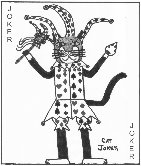 |
| Pair | Two cards of the exact same rank, such as two Queens. In order for a pair to be considered higher than a previously played pair, the two cards comprising that pair must be of a higher rank than the previously played pair during this trick. |  |
| Triple | Three cards of the exact same rank (such as three fives). In order for a triple to be considered than any previously played triple, the three cards comprising this triple must be of a higher rank than previously high played triple during this trick. | 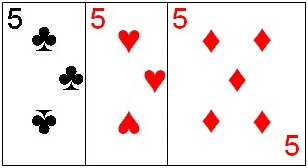 |
| Quartet | A Quartet is a combination consisting of four cards of the exact same rank (such as four Aces). In order for one quartet to be considered higher than a previously played quartet it must consist of four cards of higher rank than that previous quartet. | 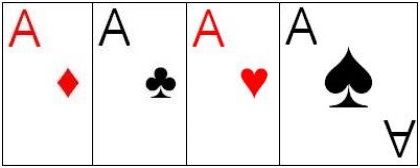 |
| Sequence of Pairs | A sequence of pair is three or more cards in direct sequence, each of these cards which is also paired with exactly one other card of the same rank (such as 5, 5, 6, 6, 7, 7, 8, 8). In comparing two such sequences of pairs, the sequence which is headed by the highest ranked pair of cards is considered higher. For two sequences in which the highest pair is of the same length, the one containing more pairs in the sequence would be considered the higher. | 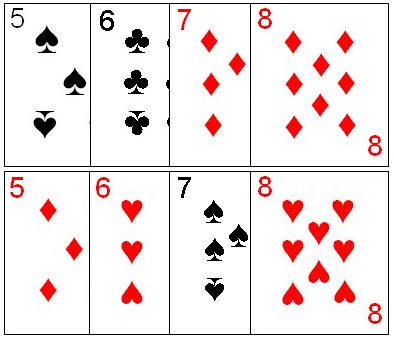 |
| Sequence of Triplets | A sequence of triplets is three or more cards in direct sequence, in which each card in that sequence is represented by exactly three cards of that rank (i.e. 3, 3, 3, 4, 4, 4, 5, 5, 5). In comparing multiple such sequences the sequence of triplets which is headed by the highest triplet is considered the highest. For two such sequences which are headed by the same highest triplet, the sequence which contains more triplets is considered the higher. | 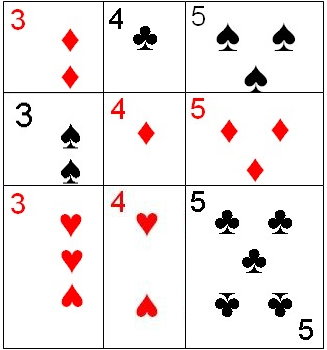 |
| Sequence of Quartets | A sequence of quartets is three or more cards in direct sequence, in which each card in the sequence is represented by exactly four cards of that rank. In comparing two such sequences of quartets, the sequence which is headed by the highest ranked quartet is considered the higher. If multiple such sequences are headed by a quartet of the same rank, the quartet consisting of the largest number of sequence quartets (longest sequence) is considered the highest. | 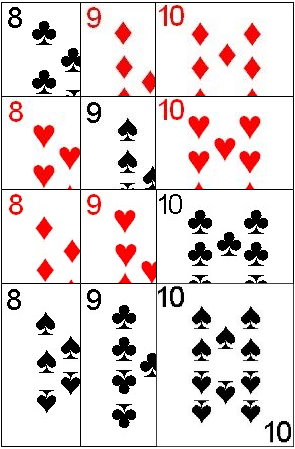 |
| Full House | A full house is a special combination which consists of exactly five cards. There are several legal types of Full House which can be played:
|  |
| Suit Sequence | A suit sequence is a combination consisting of five or more cards, all of the same suit and in direct sequence. In comparing two such sequences, the sequence which is headed by the highest ranked card is considered the highest. If multiple sequences are headed by a card of the same rank, the sequence which consists of more cards in the sequence is considered the higher. |  |
In addition to the standard combinations as thus described, there are also three special combinations (sometimes called Bombs). These special combinations can be played anytime on a players turn to beat any of the other normal combinations. The following are the three special combinations which can thus be played:
| Special Combination | Description | Example |
|---|---|---|
| Four Twos | This is a special combination consisting of exactly four cards in the rank of "two" (four twos). | 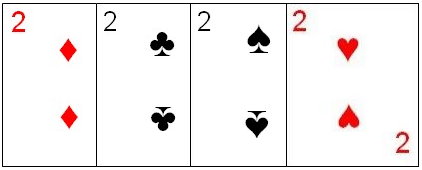 |
| Five, Ten, King, Same Suit | This combination consists of exactly three cards; one five, one ten and one King, all of the same suit. | 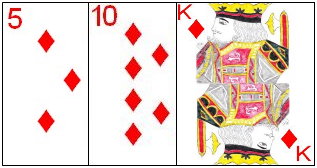 |
| Five, Ten, King, Mixed Suits | This combinations consists of exactly three cards; one five, one ten and one King, which can be of any suits. | 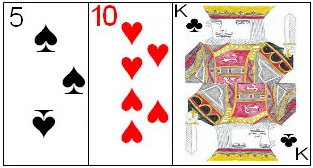 |
The hand continues until all but one player has played the last of his cards to the table in legal plays. If the last player to have cards is able to beat the last combination he is entitled to play those cards, and take those cards into his pile of won cards. However, even if that last player is able to beat the previous play, he is still considered to be the last player having cards in hand.
The player who was the last to deplete his hand of cards during the hand must give all cards won during the hand (as well as any cards remaining in his hand) to the player who was the first player to deplete his hand of cards during this hand. After this, the players then examine all the won cards from the hand for purposes of determining scoring for the hand. Certain such cards won during the hand entitle the player winning those cards to earn a certain number of points. The following chart shows the point value for the cards in the deck:
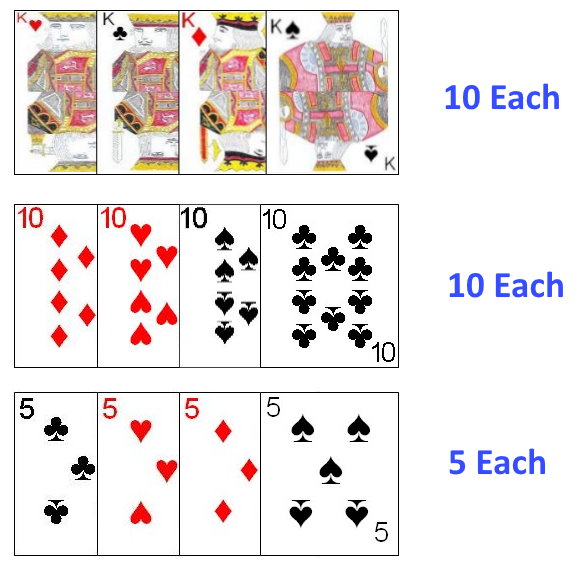 |
|
After the first hand, the player who was first to deplete his hand of cards has the first turn and draws the first card in the "deal" for the next hand. The player who was the last to deplete his hand of cards during the previous hand must shuffle the cards for the next hand.
All points earned by a player during a hand are added to an accumulated total for that player. If one or more players reach or exceed 500 points at the end of any hand, the player with the highest point total is then considered the winner of the game.